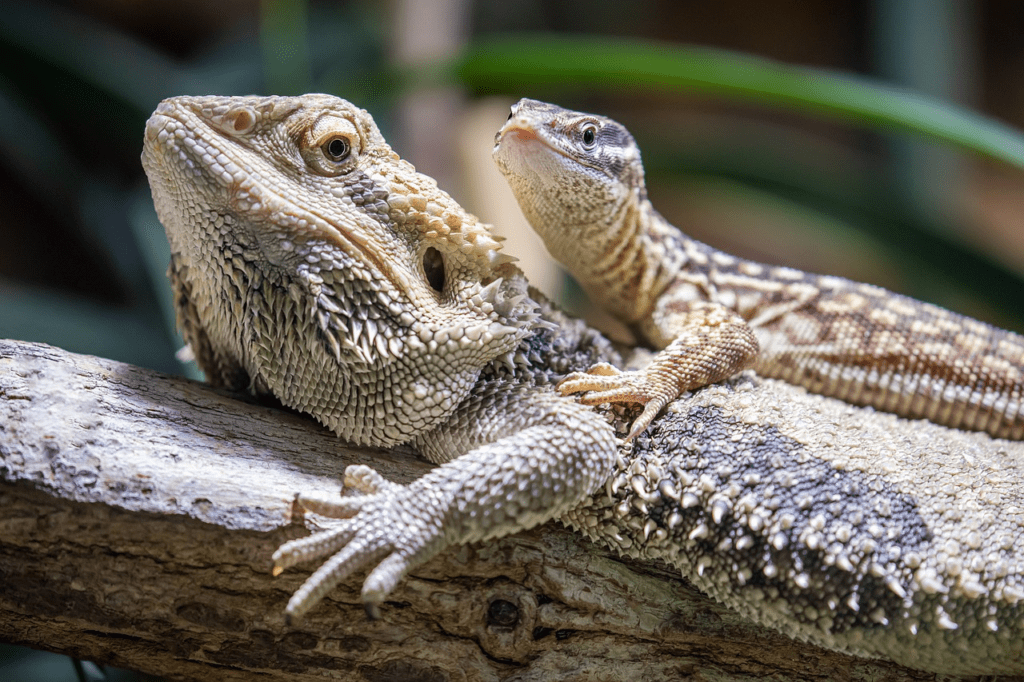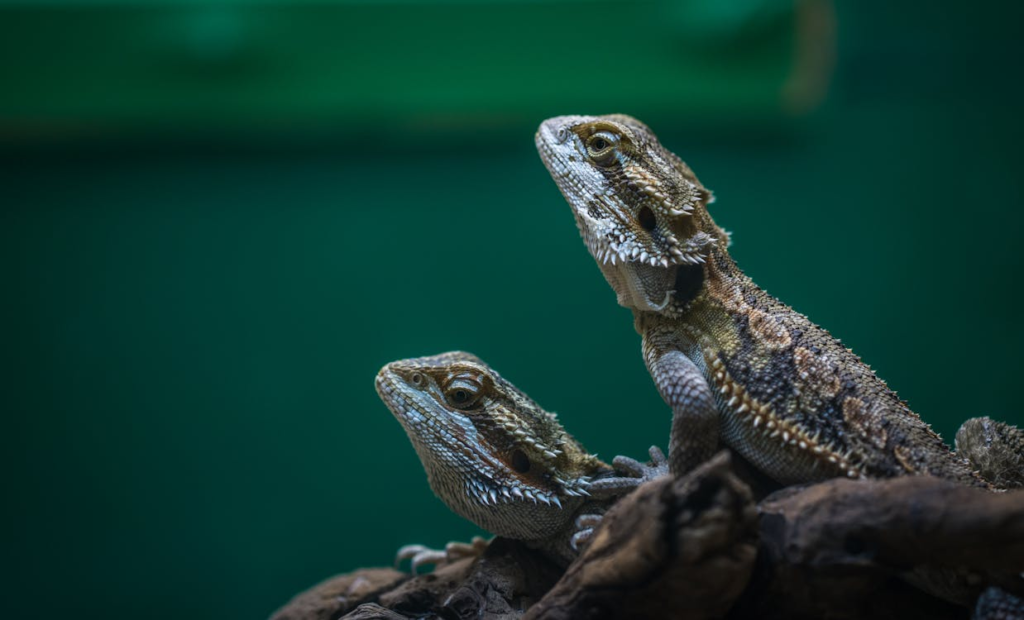
Breeding bearded dragons, also known as pogonas, is a fascinating and intricate process that requires preparation, knowledge, and dedication. From selecting the parents to caring for the hatchlings, this journey demands attention to detail at every step. In this comprehensive guide, you’ll find everything you need to carry out this rewarding task responsibly and successfully.
Selecting the Parents of your Bearded Dragon
Choosing the right parents is the first critical step to ensure healthy and strong offspring. Not all bearded dragons are ready for breeding, so you need to pay attention to several key factors:
- ① 🦎 Identifying sexes: Males have two bulges at the base of their tail, while females have a single central bulge. Males also tend to be larger and have broader heads.
- ② 🍃 Appropriate age and weight: Both males and females should be at least 18 months old and weigh over 350 grams (males) and 400 grams (females). This ensures they are fully developed for the breeding process.
- ③ ⚠️ Physical condition: Avoid breeding dragons with illnesses, injuries, or nutritional deficiencies. Ensure both are in optimal health, with adequate levels of calcium and vitamin D3.
- ④ 🦎 Temperament and behavior: Observe how the potential parents interact. Dragons that are overly aggressive or stressed may face issues during mating.
I still remember the first time I checked the sex of my bearded dragon. With a mix of curiosity and nerves, I gently lifted the tail and was thrilled to see the two bulges confirming I had a male.
Brumation: Natural Preparation for Breeding
Brumation, a state similar to hibernation, plays a crucial role in the breeding process of bearded dragons. It not only improves fertility but also prepares the female’s body for egg production.
- ① 🌡️ Inducing brumation: Gradually lower the temperatures in the enclosure and reduce daylight hours to 8–10 hours per day. Provide a nutrient-rich diet before this process begins, as dragons will eat less during brumation.
- ② ⏳ Duration: Brumation can last between 4 and 12 weeks, depending on the individual. During this time, dragons will be lethargic, hide more often, and reduce their physical activity.
- ③ 💧 Monitoring during brumation: Ensure they stay hydrated by offering fresh water at all times. Even if they don’t eat, their environment must remain safe and supportive.
- ④ ☀️ Exiting brumation: Gradually increase light and temperature levels. Reintroduce protein- and calcium-rich foods to prepare them for mating.
I remember being completely shocked the first time my bearded dragon entered brumation on his own. Without any changes in temperature or lighting, he became lethargic and stopped eating. I thought something was wrong until I learned this was perfectly normal!
Mating your Bearded Dragons: Supervision of the Process
Mating bearded dragons can be an intriguing but sometimes aggressive process. It’s essential to supervise your dragons to avoid injuries or excessive stress.
- ① 🦎 Introducing the male and female: Place the male and female in a neutral space within the enclosure. Observe their interactions; the male will show signs such as darkening his beard, head bobbing, and displaying dominant behavior.
- ② 👋 Signs of receptiveness: The female will lift one of her front legs in a “waving” motion or perform slight body push-ups, indicating readiness.
- ③ 👀 Supervised mating: Males may bite the female’s neck to immobilize her during mating. While this behavior is normal, it must be monitored to prevent harm. Separate them immediately if the male becomes excessively aggressive.
- ④ 🔄 Mating frequency: If the first attempt is unsuccessful, repeat the process several times at weekly intervals. Avoid overexposing the reptiles to stress.
Every time I watch two bearded dragons mating, it is really surprising, like witnessing a tiny part of nature’s incredible cycle.
Gestation: Specific Care for your Female Bearded Dragon
After successful mating, the female will be gravid (carrying eggs) for approximately 4–6 weeks. This period is critical to ensure the production of healthy eggs.
- ① 🥗 Intensive diet: Provide foods rich in calcium and protein, such as crickets, silkworms, and leafy greens like kale and dandelion. Use calcium powder supplements to strengthen egg formation.
- ② 💧 Constant hydration: Ensure she has access to clean, fresh water at all times. Hydration is essential during this period.
- ③ 🤰 Physical changes: As the eggs develop, the female will exhibit a noticeably swollen abdomen. You may gently palpate her belly to feel the eggs, but do so carefully to avoid harm.
Think of your gravid bearded dragon as your pregnant daughter, she needs extra care, the best food, and constant love to get through this stage. Just don’t offer her pickles and ice cream!
Preparing the Nest and Laying Eggs
When the female is ready to lay her eggs, she will display nesting behaviors, such as digging or moving restlessly.
- ① 🪺 Setting up the nest: Prepare a laying box with a mix of sand and moist soil at least 15–20 cm deep. The moisture level should allow the substrate to hold its shape when dug.
- ② 🔒 Private space: Place the box in a secluded area of the enclosure where the female feels safe and undisturbed.
- ③ 🥚 Egg laying: Once the female begins digging and laying eggs, avoid direct intervention. Carefully remove the eggs afterward without changing their orientation.
Egg Incubation
Incubation is a crucial stage that requires precise temperature and humidity to ensure successful hatching.
- ① 🌡️ Prepared incubator: Set the incubator to a temperature of 28–29 °C with a humidity level of 75–80%. Use moistened vermiculite as the substrate.
- ② ⏳ Development time: Eggs will take between 60 and 80 days to hatch. Regularly check the incubator to ensure stable conditions.
- ③ 🕵️♂️ Identifying fertile eggs: Fertile eggs are usually white and firm. Remove any that show signs of mold or decay.
Hatching and Caring for Bearded Dragon Hatchlings
When the eggs hatch, the hatchlings will need immediate care to ensure healthy development.
- ① 🛖 Enclosure for hatchlings: Provide a spacious area with a thermal gradient, with temperatures up to 35 °C in the warm zone. Ensure proper humidity levels.
- ② 🍴 Initial feeding: Offer small insects like crickets and mealworms dusted with calcium. Combine this with finely chopped fresh vegetables.
- ③ 🔍 Constant supervision: Monitor all hatchlings to ensure they are active and feeding. Separate weaker ones if necessary.

If you choose to have a baby bearded dragon it is not a bad idea to ask to a veterinarian for some extra tips.
Caring for Juvenile Bearded Dragons
As the hatchlings grow into juveniles, they require more space and a balanced diet.
- ① 🪴 Adequate space: Expand the enclosure to accommodate the growing dragons. Ensure enough room for each individual.
- ② 🥦 Diet: Introduce a greater variety of vegetables and proteins. Continue supplementing their diet with calcium.
- ③ 🕊️ Behavior monitoring: Watch for signs of dominance or aggression among juveniles and separate them if needed.
Breeding bearded dragons is an exciting and challenging process that demands dedication and detailed knowledge. By following these steps and providing proper care at each stage, you will not only ensure the well-being of your reptiles but also enjoy a unique experience as a breeder. Prepare thoroughly, be patient, and immerse yourself in the incredible world of pogona breeding.
